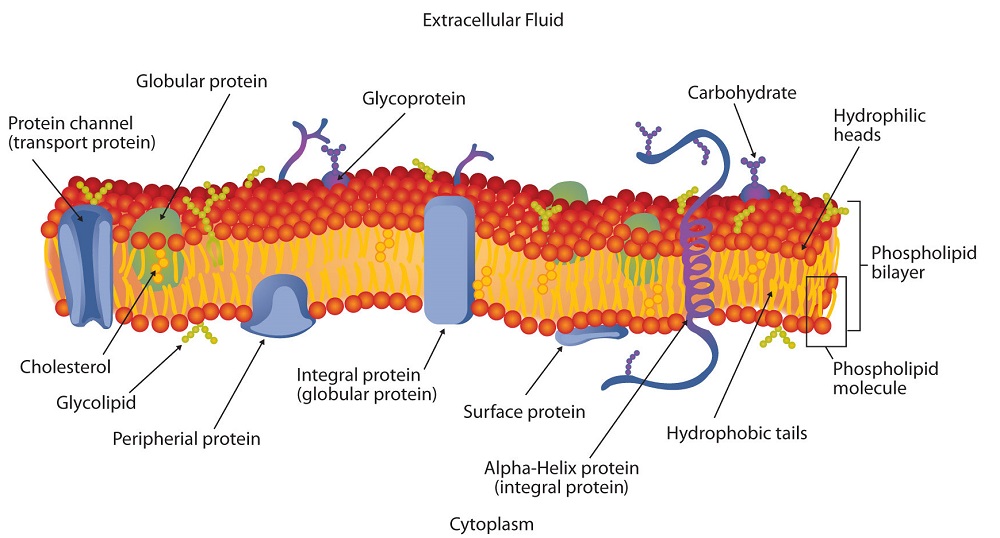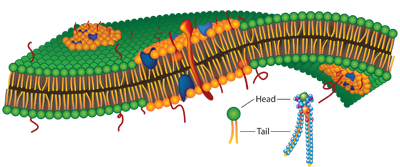Modeling oxygen diffusion through biological lipid membranes using inverse Monte Carlo
Modeling oxygen diffusion through biological lipid membranes using inverse Monte Carlo
Promotor(en): A. Ghysels /16MODEV02 / Model and software developmentLipid membranes are omnipresent in the human body and can be found around every cell and organelle. Biological membranes usually consist of lipid bilayers, where these have a hydrophilic head and two hydrophobic tails (Fig. 1). Chemical variety in head groups and tails provides a large variety in phospholipid compositions in the human body. Membranes moreover may contain cholesterol molecules. Lately, the existence of ordered domains rich in cholesterol has been linked to the concentration in sphingomyelin, a specific group of phospholipids. These nanoscale domains, called rafts (Fig. 2), are surrounded by disordered domains that are poor in cholesterol. It has been suggested that these rafts play a role in signal transduction and intracellular transport through their interaction with proteins embedded in the membrane. Moreover, the existence of two phases (ordered versus disordered) must have consequences for the transport of small molecules through the membranes. This thesis focuses on the transport of molecular oxygen, which is of utmost importance for the energy household of the cell. It is suspected that oxygen diffusion is different in the ordered than in the disordered domains. Since oxygen diffusion is difficult to measure experimentally, explicit molecular dynamics simulations are a valuable tool to study oxygen mobility.

FIG. 1 A biological membrane is a bilayer of phospholipids. Many other molecules are embedded in the membrane, such as cholesterol and transmembrane proteins.
FIG. 2. A bilayer of lipid molecules (green heads, yellowish tails) is studded with proteins (various shapes and colors). The orange sections represent lipid rafts, which are areas of higher lipid density that attract and concentrate certain proteins, suggesting that the cell membrane might play an active role in regulating protein function. The inset shows a phospholipid. Oxygen mobility is suspected to be different in the rafts.Goal
The primary goal of this thesis is to study the diffusive pathways followed by oxygen molecules through the membranes. The question to be answered is how oxygen can pass the barriers formed by the membranes before being consumed in the mitochondria. Oxygen diffusion is usually modeled with molecular dynamics by integrating Newton’s equations and creating an ensemble of trajectories. The thesis aims at extracting diffusion information from these trajectories, which is not available experimentally.
The first part of thesis is the theoretical development of a theory for diffusion in a anisotropic and inhomogeneous medium. The starting equation is the Smoluchowsky equation, a generalized formulation of diffusion with a position-dependent diffusion profile, and also known as the Fokker-Planck equation. The solution of the equation is the propagator, which plays the role of a Green’s function: it gives the probability of diffusion a certain distance in a given lag time. Diffusion in a homogeneous and isotropic medium is described by a simple Gaussian function, but in anisotropic and inhomogeneous media the solution of the Smoluchowsky equation is selden available analytically. Therefore the propagator will be determined from the simulated trajectories with inverse Monte Carlo. Experience with this technique is already present in the Center for Molecular Modeling for membranes without rafts. For a system with rafts, a new theoretical extension will need to be developed.
The second part of the thesis is the practical implementation and thorough validation of the new theory. A system with and without rafts will be considered, with a mixture of ordered and disordered domains. Diffusive oxygen trajectories will be simulated with the CHARMM software package. The post-processing of the molecular dynamics trajectories will provide us with detailed information on the oxygen pathways through the cell membranes. The new theory for anisotropic ordered/disordered domains should give information on how diffusion occurs within and outside the rafts.
The research question of anisotropic diffusion is here described for oxygen mobility, but the concepts are applicable in other anisotropic media as well, such as diffusion through porous crystals. The topic combines biophysics, statistical physics, method development, implementation, computer experiments, statistics, and plain physical insight in the biomedical research field.
Mobility
This research topic will be conducted in the framework of a strong international network and if possible the student will be actively involved in work discussions with collaborative partners.Motivation Appl. Phys.
The physics aspect is the theoretical development of a diffusion propagator in anisotropic and inhomogeneous media. The engineering aspect is the development of an inverse Monte Carlo technique to extract the diffusive information from simulated trajectories.
- Study programmeMaster of Science in Engineering Physics [EMPHYS], Master of Science in Physics and Astronomy [CMFYST]ClustersFor Engineering Physics students, this thesis is closely related to the cluster(s) NANO, MODELINGKeywordsDiffusion, Monte Carlo, inhomogeneous media, phospholipids, oxygen transport, respiratory cycle


